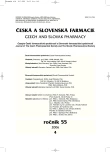Štúdium kvalitatívnych vlastností silice Tanacetum vulgare L.
A Study of Qualitative Properties of the Essential Oil of Tanacetum vulgare L.
The study examined the qualitative properties of the essential oil obtained from the flower heads of the species Tanacetum vulgare L. The composition of the essential oil was evaluated in plants from various localities, which differed in the altitude, temperature gradient, as well as soil-climate conditions. With the use of gas chromatography (GC/MS), 49 constituents of the essential oil were separated, out of which 35 was identified. The shares of the constituents in the essential oil differed in dependence on the locality. In the lowest-lying locality with a relatively large sunshine, the content of ß-tujons in the essential oil was the highest, whereas in the regions lying towards the north the content of the essential oil was decreased and the content of camphor was increased. In the northernmost region an increased number of chemovars of the camphor-cineole type was observed. In conclusion, it must be said that different climatic and agrotechnical conditions, geographical origin and adaptation of the genotypes of Tanacetum vulgare to the growth conditions can be the causes of the found chemotypes in the localities under examination.
Key words:
Tanacetum vulgare L. – essential oil – chemotype
Autoři:
Š. Vaverková; M. Mikulášová 1; M. Habán 2; P. Sloboda
Působiště autorů:
Univerzita Komenského v Bratislave, Farmaceutická fakulta, Katedra farmakognózie a botaniky
; STU Bratislava, Fakulta chemickej a potravinárskej technológie, Katedra biochémie a mikrobiológie
1; SPU Nitra, Fakulta agrobiológie a potravinových zdrojov, Katedra agrobiológie a herbológie
2
Vyšlo v časopise:
Čes. slov. Farm., 2006; 55, 181-185
Kategorie:
Původní práce
Souhrn
V práci sa sledovali kvalitatívne vlastnosti silice získanej z kvetných úborov druhu Tanacetum vulgare L. Zloženie silice sa hodnotilo u rastlín z troch rôznych lokalít, ktoré sa líšili nadmorskou výškou, teplotným gradientom, ako i pôdnoklimatickými podmienkami. Za použitia plynovej chromatografie (GC/MS) sa oddelilo 49 zložiek silice, z ktorých 35 bolo identifikovaných. Zastúpenie obsahových látok v silici sa líšilo v závislosti od lokality. V najjužnejšie položenej lokalite s pomerne veľkým slnečným svitom bol obsah ß-tujón v silici najvyšší, kým smerom k severnejším oblastiam sa obsah silice znižoval a zvyšoval sa obsah gáfru. V najsevernejšie položenej oblasti možno pozorovať zvýšený počet chemovarov gáfrovo-cineolového typu. Záverom treba povedať, že odlišné klimatické a agrotechnické podmienky, geografický pôvod a adaptácia genotypov Tanacetum vulgare k rastovým podmienkam, môžu byť príčinou zistených chemotypov v sledovaných lokalitách.
Klúčová slova:
Tanacetum vulgare L. – silica – chemotyp
Štítky
Farmacie FarmakologieČlánek vyšel v časopise
Česká a slovenská farmacie

2006 Číslo 4
- Ukažte mi, jak kašlete, a já vám řeknu, co vám je
- Psilocybin a neurodegenerace: Kam míří současný výzkum?
- FDA varuje před selfmonitoringem cukru pomocí chytrých hodinek. Jak je to v Česku?
Nejčtenější v tomto čísle
- Inhibítory enzýmu konvertujúceho angiotenzín
- Naftochinony – biosyntéza, výskyt a metabolismus v rostliná
- Vlastnosti benzethonium chloridu v micelárních roztocích a vliv přídavku chloridu sodného
- Protektivní efekt flavonoidů osajinu a pomiferinu na ischémii – reperfuzi srdce
